 | |
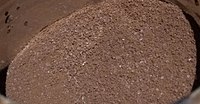 Nesquik cocoa powder Nesquik cocoa powder | |
| Product type | Powder, syrup, beverage |
|---|---|
| Owner | Nestlé |
| Produced by | Nestlé |
| Country | United States |
| Introduced | 1948; 77 years ago (1948) |
| Related brands | Nesquik Cereal |
| Markets | Worldwide |
| Website | nesquik.com |
Nesquik is a brand of food products made by Swiss company Nestlé. In 1948, Nestlé launched a drink mix for chocolate-flavored milk called Nestlé Quik in the United States; this was released in Europe during the 1950s as Nesquik.
Since 1999, the brand has been known as Nesquik worldwide. Today, the Nesquik name appears on a wide range of products, including breakfast cereals, powdered mixes for flavored milk, syrups, ready-to-drink products, candy bars, fondue fountains, hot chocolate mix, and more.
History
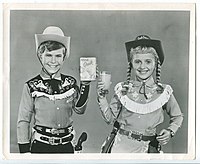
Nesquik began as a chocolate powdered flavoring mix in the United States in 1948, as Nestlé Quik. In the 1950s, it was launched in Europe as Nesquik. In countries with the Quik term (including the U.S., Canada, Mexico, and Australia, where it was originally marketed under the name Nestlé's Quik), the name was changed to the worldwide brand Nesquik in 1999. The same year, Cereal Partners Worldwide introduced Nesquik Cereal, a breakfast cereal that "turns milk into chocolate milk", which is similar to Cocoa Puffs. Nesquik syrup products were introduced in 1981 and ready-to-drink products were introduced in 1984.
On 8 November 2012, Nestlé USA issued a voluntary recall of limited quantities of Nesquik Chocolate Powder made and sold in the United States. These that were recalled were of the 10.9-, 21.8-, and 40.7-ounce (309 g, 618 g, 1150 g) tins. This recall only affected the chocolate variety; it did not affect the other varieties of the mix or any other Nesquik products. This was the first known recall of a Nesquik product. These tins were taken off the market after Nestlé was informed via a supplier, Omya Inc. that it had issued a recall of certain lots of one of its own products, calcium carbonate for Salmonella contamination. The affected Nesquik chocolate mix was produced during early October 2012. All affected products had an expiration date of Best Before October 2014. Nestlé issued a statement on the recall stating, "We apologize to our consumer and sincerely regret this incident."
On 1 April 2013, the official Facebook page of Nesquik USA posted a photo on their page depicting a broccoli-flavored ready-to-drink flavor of Nesquik. However, upon closer inspection of the photo, there was a notice in the lower-left corner that it was not an actual Nestlé product. Nesquik USA announced later in the same day that it was an April Fool's joke.
In January 2017, Nestlé food scientists outlined a strategy to reformulate their drink mix to remove over half of the sugar content, citing consumer backlash against sweetened mixes and beverages.
On 26 August 2023, Nestle South Africa announced that the company would discontinue both the Strawberry and Chocolate flavors in the country.
Products
Mixes

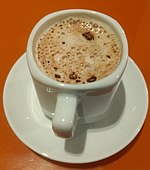
- Nesquik Chocolate Powder was introduced in 1948.
- Nesquik Banana Powder was introduced in 1954.
- Nesquik Strawberry Powder was introduced prior to 1960.
- Nesquik Vanilla Powder was introduced in 1979, but this was discontinued in 2006 due to low sales.
- Additional powder flavors have been introduced, but discontinued: Cherry (1989–1995), Mango (1991–2000), Cream (1997), Triple Chocolate (2002–2006), Honey (2001–2006), Crème Soda (sold in South Africa until 2015), Caramel (?–2006), Cookies & Cream.
Ingredients
The ingredients of the "classic" chocolate powder are:
- Sugar
- Cocoa powder processed with alkali
- Soy lecithin
- Carrageenan
- Salt
- Natural flavor
- Spice
- Vitamins and minerals:
- Sodium ascorbate (vitamin C)
- Ferric pyrophosphate (iron III)
- Niacinamide
- Zinc oxide
- Thiamin hydrochloride
- Copper gluconate
- Manganese sulfate
- Biotin
Syrups
Nesquik chocolate syrup was introduced in 1981. Strawberry was added in 1989. Vanilla was added in Canada in 2021. Mixed flavors such as Strawberry Banana and Chocolate Caramel have also been produced.
Ready-to-drink
Not including refrigerated Nesquik, which is made by Saputo Dairy.
- Nestlé introduced ready-to-drink Nesquik (Quik at the time) Chocolate Milk in 1983. Strawberry was added in 1987, and Banana was added in 1990. Vanilla, Double Chocolate, and Banana-Strawberry are also available.
- Fat-Free Nesquik Chocolate Milk was introduced in 1998.
- Nesquik Milkshakes come in Chocolate and Strawberry. Chocolate Caramel was introduced in 2007.
- Nestlé introduced Nesquik "Magic" Straws in 2008
The ready-to-drink versions of Nesquik ended production in 2009 in the U.K.
Ingredients
The ingredients of the ready-to-drink chocolate milk are:
- Reduced fat milk with vitamin A palmitate and vitamin D3 added
- High fructose corn syrup
- Less than 2% of:
- Cocoa powder processed with alkali
- Nonfat milk
- Sugar
- Calcium carbonate
- Natural and artificial flavors
- Guar gum
- Salt
- Carrageenan
Cereal
Main article: Nesquik (cereal)Nesquik Cereal is a breakfast cereal first manufactured by Cereal Partners in 1999. The cereal consists of small (about 1 cm (0.4 in) in diameter) chocolate Whole grain hollow spheres. Nesquik Cereal is most similar to General Mills' Cocoa Puffs; it is also their most direct competitor.
Nesquik Cereal is sold in dozens of countries worldwide such as the U.K., Sweden, Canada, Mexico, France, and Hong Kong. It is sold throughout Europe, Africa, Asia, Oceania, the Middle East, South America, and parts of North America. It is currently available in 43 countries. It is available in 30 grams (1.1 oz), 375 grams (13.2 oz), 500 grams (18 oz), and 700 grams (25 oz) package sizes. Most Nesquik Cereal is manufactured in France by Cereal Partners.
It is also available in two other varieties: CioccoMilk (a filled square-shaped chocolate puffed rice-and-corn cereal), and Duo (the original variety, but with white chocolate flavored rice-and-Puffcorn. A third variety was introduced in certain regions of EMEA and Kerela called DittoMilk but was discontinued.)
Other
 Chocolate bar
Chocolate bar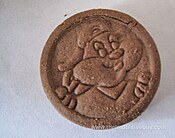 Chocolate cookie
Chocolate cookie
- Nesquik chocolate candy bars were originally known as Nestlé Quik candy bars before the 1999 name change.
- A Nesquik Chocolate Fondue Fountain was made by Smart Planet Home, using the Nesquik name and logo under license.
- A Nesquik flavor of Nestlé hot cocoa mix features bunny-shaped marshmallows and advertises 38% more calcium than regular hot cocoa.
- Nesquik Chocolate Pots, a chocolate fromage frais range was available in the U.K..
- Nesquik is available for the Dolce Gusto system.
- Nesquik is available as a flavor of Ice-Screamers frozen novelties made by Nestlé.
- Nesquik sponsored a Nesquik race car for advertising and marketing purposes.
- Nesquik Milk Slice, a sponge cake with chocolate flavor yogurt filling is available in the U.K.
Advertising campaigns
Nesquik has had hundreds of various advertising campaigns over its long history. It has had ads from print ads to ads at the Tour de France, and Olympics in recent years. It has been advertised with close to one dozen mascots.
Jimmy Nelson, Danny O'Day, and Farfel
In 1955, Nestlé hired ventriloquist Jimmy Nelson to do its advertising on children's television programming. Nelson's dummy Danny O'Day would say that Quik "makes milk taste...like a mill-ion" (dollars). Danny and a dog named Farfel would finish the commercials by singing Nestlé's brand-new signature jingle:
- Danny: N-E-S-T-L-E-S,
- Nestlé's makes the very best...
- Farfel: Choc-'late
Farfel would finish with the sound of his jaw snapping shut. This effect was accidentally invented when Nelson's sweaty finger (a result of nervousness) slipped off the mouth control during his first audition in front of the Nestlé executives. This would normally be a serious technical mistake for a ventriloquist, but they actually liked it so much that they insisted that Nelson keep it in. Nelson performed the jingle that way for 10 years.
Nesquik Bunny (a.k.a. Quicky)
Main article: Quicky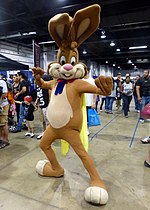
A cartoon Quik Bunny first appeared on the cans of the strawberry flavor when it was introduced. Later, an anthropomorphic animated bunny wearing a large red "Q" on a collar-like necklace, was introduced in television commercials as the new chocolate Quik mascot. He debuted in 1960 and first appeared in his first TV commercial in 1973. The character is voiced by Barry Gordon.
He sings Nesquik's most famous jingle in a rock-and-roll rhythm:
It's so rich and thick and chocolate,
That you can't...drink it slow...
if it's Quik
Then he vocalizes only four notes "oh-do-be-oh" and instead of vocalizing the fifth note which is "doh", he immediately sucks all of his drink down through a straw, then finishes the rhyme by forlornly intoning, "That's the saddest sound I know."

In the U.S. by 1999, the Quik Bunny was renamed the Nesquik Bunny and his "Q" changed to an "N" when the brand name was changed. He appears on the packaging and marketing and has appeared in the product's television commercials. The artist who made the redesign of the Bunny for its global implantation in the '90s was the cartoonist Ramon Maria Casanyes. In France, Italy, and Canada, he is known as Quicky the Nesquik Bunny. In Spain, there was no mascot prior to the introduction of Quicky in 1990/1991.
The Nesquik Bunny is also featured on the packaging and advertisements for other Nesquik products.
Appearances in other media
| This section does not cite any sources. Please help improve this section by adding citations to reliable sources. Unsourced material may be challenged and removed. Find sources: "Nesquik" – news · newspapers · books · scholar · JSTOR (October 2022) (Learn how and when to remove this message) |
- The Quik Bunny was parodied in the animated television series Drawn Together episode "Unrestrainable Trainable" where he was found engaging in sexual activity with three of the main characters and stunned at the contents of his "chocolate milk".
- A 1987 promotional comic with Superman.
- A 1984 The Adventures of Quik Bunny comic featuring Spiderman.
- A Quik Bunny balloon had been a staple of the Macy's Thanksgiving Day Parade from 1988 until 1999.
- A 2013 advertisement on Nickelodeon featuring Sam & Cat co-stars Ariana Grande and Jennette McCurdy.
Groquik (Quikáras)
France and Greece first had another mascot for Nesquik, which was a giant fat yellow hippopotamus-like cartoon creature with a deep voice, wearing a hat with red and white stripes, called Groquik—a variation of Gros Quik ("Fat Quik"), created by Gilbert Mast and puppeteered by Yves Brunier. In Greece, the mascot was called Κουικάρας (or Quikáras—English: "Big Quik"). He was later replaced by Quicky, much to the discontent of fans who protested against the lack of a sympathetic character and the Americanism.
The character was created in 1978. His first appearance was in the French magazine Téléjunior in April 1979. The designer of the character was Gilbert Mas. In the French advertisements where Groquik was depicted, he was a puppet character portrayed by renowned French puppeteer Yves Brunier, who manufactured and portrayed puppets as a ventriloquist. He has also created famous characters such as Casimir, L'Île aux enfants, and worked on The Muppet Show.
The Greek character's catchphrase was: "I have a craving for Nesquik!" (at the time, this translated into Quik, as the name had not yet been changed) The French character's catchphrase was the same, but in French. These catchphrases were passed on to their successor, the Nesquik Bunny. In the Greek television ads, Quikaras would chase after thieves who kidnapped children, after trying to steal their Quik; the children refused to give their Quik to the thieves, so the thieves stole the children along with the Quik. Quikaras would catch the thieves, saved the children, and returned the Quik to the children. Over the years, this basic advertising format spawned various variations, such as ads where pirates stole Quik and kidnapped children, and they were saved by Kouikaras; another version followed the basic format, but was instead set in space. Many other versions followed this format, and some still follow this format today with the Nesquik Bunny.
The last ad with Quikaras (which was played in Greece) showed a train at a train station soon to be leaving the station. Quikaras was at the station, and dozens of children at the station said goodbye to Quikaras, soon after he boarded the train, and it began to leave the station. As it left the station, and the children waved goodbye, thieves once again stole the Quik, and Quicky the bunny (who had been at the station the entire time) caught the thieves and returned the Quik back to the children.
In 2001, Nesquik launched a website, which was dedicated to Groquik. The website contained old Nesquik commercials and advertisements, contests, e-cards, logos, and more.
Cangurik
In Portugal, the mascot was a kangaroo, Cangurik, which was replaced by Quicky in 1989/1990. The song "Cangurik" was recorded by Suzy Paula in 1982. Joel Branco recorded "Uma Árvore, Um Amigo", with Cangurik on the cover, in 1984. "Amigos do cangurik" (1986) was a collection of trading cards. There was a club named "Clube do Cangurik".
Mr. Nesquik
In Italy, before the arrival of Quicky, the mascot was an anthropomorphized box of Nesquik called Mr. Nesquik. Especially in the 1980s, he represented a popular and easily recognizable advertising character thanks to TV commercials (featuring an iconic jingle based on the music of Oh! Susanna), press advertisements (most notably on Topolino comic books), and to the many complimentary gadgets included with every box of Nesquik powdered chocolate throughout the years, all bearing his image. Mr. Nesquik made his final appearance around 1990, concomitant with Quicky's introduction, for the promotion of a new gadget, the Volaquik, already depicting the latter character, making for a symbolic relay between the two mascots.
Nesquik Cereal
Nesquik Cereal is advertised in the 43 countries in which it is sold. It is mainly marketed via television, though there have been several online and print ads for the product. All ads for the cereal tend to include the Nesquik Bunny.
2012–2013 attempted TV ad ban in England
| This section may contain an excessive amount of intricate detail that may interest only a particular audience. Please help by spinning off or relocating any relevant information, and removing excessive detail that may be against Misplaced Pages's inclusion policy. (October 2022) (Learn how and when to remove this message) |
The attempted ban revolved around a Nesquik chocolate powder TV ad, created by Momentum London, which attracted five complaints to the Advertising Standards Authority. The ad for Nesquik chocolate milkshake stated: "You know, kids only grow up once, which is why they pack their days full of the good stuff. So start theirs with a tasty glass of Nesquik at breakfast. It has essential vitamins and minerals to help them grow and develop, because all this laughing and playing can be hard work."
An animation showed the ingredients "Vitamins D, B & C", "Iron", and "Magnesium" adjacent to a glass of the product, mixed with milk. On-screen text during the ad read, "Enjoy Nesquik as part of a balanced diet and healthy lifestyle".
Some consumers were angered, complaining the ad encouraged poor nutritional habits, as the advertisement had suggested that the product was suitable to give for breakfast to children on a daily basis. Five of them reported the advertisement to Ofcom. Clearcast, the agency that regulates television advertisements, said that it understood that the amount of sugar that is in a single glass of prepared chocolate Nesquik is "well within" the World Health Organisation's guidelines for daily sugar consumption.
To support its case and defense, Nesquik commented on the ad's reference to iron, magnesium, Vitamin B, Vitamin C, and Vitamin D. It said that health claims for these micronutrients, in relation to growth and development and maintenance of bones and teeth, had been positively tested by the authorities. Nestlé also said that the benefits of drinking milk were well known and that Nesquik was suitable to be consumed once a day, as part of a balanced diet and health promotion.
The ASA ruled in favor of Nestlé, saying that it noted that Nestlé provided nutritional information on its packaging and website. Furthermore, it said it did not consider that the level of sugar in the product was so high as to preclude sensible daily consumption. The ASA ruled that further action was not necessary.
In popular culture
| This section may contain irrelevant references to popular culture. Please help Misplaced Pages to improve this section by removing the content or adding citations to reliable and independent sources. (October 2022) |
- Southern Baptist minister and comedian Reverend Grady Nutt told a joke in his stand-up act in which a minister, possessing a suitably charismatic voice, could read the ingredients off a box of Nestlé's Quik, putting the proper meaning and interpretation into words like niacin, thiamine, and riboflavin, "and people would stand weepin' and volunteerin' for foreign missions!"
- In "The Launch Acceleration" episode of the fifth season of the TV series The Big Bang Theory, it was revealed that Strawberry Quik (along with Pepto-Bismol) is the favorite pink fluid of Dr. Sheldon Cooper in a "hot date" with Dr. Amy Farrah Fowler, as the latter attempts to transfer his attachment to several items towards her.
- In Disney's 2012 film Wreck-It Ralph, the Nesquik chocolate milk mix appears when Fix-It Felix and Sergeant Calhoun fall from a double-stripe in Sugar Rush. The sign in the mix says "Nesquik Sand" (a pun on the word "quicksand".)
- In the 140th episode of Epic Meal Time, the cast of the Canadian web series created a chocolate-filled breakfast with Nesquik-covered bacon.
- Tyler Zetting, the starting goalie for Western Washington University's men's hockey team, said that he made a promise early in their team's season. "I don't know why I said this, but I promised the whole team Nesquik if we won the national championship", he reportedly said. After each win for the team, they would reportedly chant: "One game closer to Nesquik." After they won the National Associated of Intercollegiate Hockey Championships in Buffalo, NY on 17 March, Zetting said, "The first thing we chanted after we won, as we were taking our pictures, the whole team started chanting, 'Nesquik,'" Zetting said. "Everyone in that rink was like, 'What are they saying?' And I had to buy everyone Nesquik."
- A parody of Groquik appeared in episode 7 of Les Kassos, in which he does a poor job at hiding his racism.
See also
References
- ^ "About Nesquik- Brand Heritage". Nestlé Middle East FZE. Archived from the original on 14 November 2015. Retrieved 17 January 2015.
Developed in the United States of America in 1948, we were originally known as Nestlé Quik In the 1950s the brand was launched in Europe as NESQUIK®. This followed with a worldwide name change for the brand and then from 1999 onwards it became NESQUIK® in all countries.
- "Nesquik Breakfast Cereal". Nestlé. Retrieved 17 January 2015.
The only breakfast cereal with the irresistible taste of Nesquik chocolate in every bite.
- ^ "Chocolate and Strawberry Powder, Syrup, and Products – NESQUIK". Nestlé. Retrieved 15 July 2015.
Nesquik Powder Nesquik Syrup Nesquik Ready-to-Drink
- "Nestlé USA Announces Voluntary Recall of NESQUIK® Chocolate Powder". FDA.gov. 8 November 2012. Retrieved 4 April 2013.
- Bengle Gilbert, Carol. "Nesquik Recall Q and A: Are Your Kids Safe?". Yahoo! News. Retrieved 4 April 2013.
- McMullen, Laura (12 November 2012). "HealthBuzz: Salmonella Concerns Prompt a Nestlé Recall". US News. Retrieved 4 April 2013.
- "RECALL: Nestlé NESQUIK Chocolate Powder Recalled For Salmonella". Novi Patch. Archived from the original on 18 November 2012. Retrieved 4 April 2013.
- "Nesquik Chocolate Powder recalled". CBS News. 8 November 2012. Archived from the original on 9 November 2012. Retrieved 4 April 2013.
- Hsu, Tiffany (9 November 2012). "Nestlé recalls Nesquik chocolate powder over salmonella concerns". Los Angeles Times.
- "April Fool's: Nesquik Launches Broccoli Milk". ShoppingBlog.org. Retrieved 5 April 2013.
- "April Fools Goes High Tech In A Big Way". HSJ.org. Archived from the original on 8 July 2013. Retrieved 5 April 2013.
- Blackstone, Brian. "Nestlé Seeks to Sweeten Nesquik Sales by Cutting Back on Sugar". The Wall Street Journal. Retrieved 6 February 2017.
- Abrahams, Marchelle (28 August 2023). "Cry with us! Nestlé to discontinue Nesquik in South Africa". Independent Online. Retrieved 23 September 2024.
- (in Portuguese) Nesquik Caramel – Nestlé | Calories of the food Archived 4 March 2016 at the Wayback Machine (relatively caloric for a product marketed at children, was sold in Brazil along the decades of 1990 and 2000)
- "Nesquik Powder Chocolate 9.3 oz". Archived from the original on 7 December 2016. Retrieved 14 April 2017.
- "Lose weight & improve your health with a real food diet – Fooducate". Retrieved 14 April 2017.
- Thompson, Stephanie (29 March 1999). "NesQuik Redux: Here Comes The Cereal". Brandweek. Archived from the original on 9 November 2014. Retrieved 3 April 2013.
- "Making healthy breakfasts easier" (PDF). nestle.com. Nestlé. Archived (PDF) from the original on 10 February 2013. Retrieved 2 April 2013.
- "NCF-1NesquikChocolateFondueFountain.pdf" (PDF). Smart Planet Home. Archived from the original (PDF) on 5 March 2016. Retrieved 3 April 2013.
- "Nesquik Stuff Gallery". Taquitos.net. Retrieved 13 April 2013.
- J.C. Johnson (2005). "Jimmy Nelson: Warm Memories of Danny O' Day, Farfel, & Chaaawwwwclate". Talking Comedy.com. Retrieved 16 November 2010.
- "Advertising Design". Ramon Casanyes SL. Retrieved 29 May 2016.
- Nesquik TV Spot, 'Bunny Ears' Featuring Ariana Grande, Jennette McCurdy. Retrieved 5 December 2024 – via www.ispot.tv.
- S., Michelle. "Interview with Yves Brunier/ Casimir". I'ile aux enfants. Retrieved 5 April 2013.
- "Quicky the rabbit isn't Nesquik's only beloved mascot". www.mashed.com. Mashed. September 2020. Retrieved 23 March 2021.
Italy kept things simple, if a little unimaginative, with an animated box of Nesquik named Mr. Nesquik.
- "Pubblicità Nesquik - Mr Nesquik: il computer. (1985)". youtube.com. 28 January 2013. Retrieved 20 April 2022.
- "Le Storia di Nesquik". Nesquik.it. Retrieved 26 March 2021.
- "Le sorpresine del Nesquik". Alabarda Spaziale. Retrieved 26 March 2021.
- Reynolds, John (27 March 2012). "Nesquik chocolate milkshake TV ad escapes ban". Marbanning Magazine. Retrieved 5 April 2013.
- "Chocolate Breakfast (Go balance yourself)". Epic Meal Time. 19 March 2013. Retrieved 5 April 2013.
- "WWU hockey club drinks in national title". The Bellingham Herald. 25 March 2013. Archived from the original on 28 June 2013. Retrieved 5 April 2013.
- Canal+. "Grocouak, personnage de la série Les Kassos". Retrieved 14 April 2017.
External links
| Chocolate drinks | |||||
|---|---|---|---|---|---|
| Traditional drinks (maize and cacao) |  | ||||
| Generic drinks | |||||
| Brand names |
| ||||
| Lists | |||||